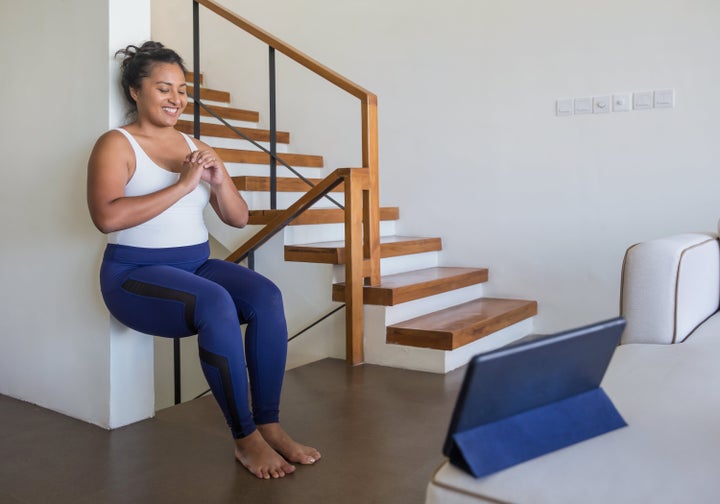
You’re reading Move, the nudge we need to get active, however makes us happiest and healthiest.
Backs can be such a pain. Many people suffer chronic discomfort, from tight shoulders thanks to hunching over the computer to lower backaches due to a herniated disc or a muscle strain.
Having a bad back can range from aggravating to debilitating. But unless you’re laid up with an acute injury, back issues shouldn’t inhibit your daily activity. In fact, regular movement, stretches and strengthening can help you both recover from and prevent further injury. It’s just a matter of learning which types of exercise are best suited to targeting issues around the spine.
HuffPost spoke with spine experts and physical therapists, who gave tips on the best and safest workouts for bad backs. Here’s their advice:
First, figure out the issue
According to Jaspal Singh, director of interventional spine in the department of rehabilitation medicine at Weill Cornell Medicine, the first step in treating back pain is pinpointing what kind you’re dealing with.
Singh recommended booking a consultation with a physiatrist, who can evaluate your symptoms and ask you specific questions related to your pain. Some doctors may conduct imaging depending on the severity of the injury.
Injuries to the discs in between the bones of the spine are most common among young people, Singh said. If it hurts when you sneeze or cough, or when you bend forward or flex your spine, that’s an indicator you might have a herniated disc.
If that’s the case, you’ll want to avoid exercise that puts any extra strain on the disc, such as heavy lifting and high-impact activities that involve running and jumping, or any moves that involve bending forward or leaning back, like certain forward folds in yoga, as well as crunches and situps. Sometimes, this can include cycling too, if the seat posture has your spine flexed forward.
If it hurts when you sit, but not when you bend forward, you might have a muscle or joint strain instead of a disc issue. “When you’re sitting, the best way to decompress the spine is to take the pressure off it, so, standing up, leaning back or getting a sitting/standing work-station,” Singh said.
Gently engage your upper back muscles
If you’re dealing with upper back or shoulder aches and tightness, Singh suggested resistance band rows, reverse snow angels, and scapular retraction— exercises that engage the mid-shoulder blades.
This will help you strengthen the area and prevent future injuries. Start with body weight or resistance bands, as Singh mentioned, before progressing to dumbbells or other weights.

Opt for low-impact cardio
Regardless of the type of back pain you’re dealing with, low-impact cardio will be beneficial.
Singh recommended activities like swimming, cycling (if you’re seated with your spine straight, as opposed to leaning forward, which would put too much stress on the lower back), walking and using an elliptical machine. These are all good aerobic options, keeping the blood flowing and muscles flexible, without putting too much strain on your joints.
Running and jumping, like in calisthenics and some HIIT workouts, can be too high-impact and put too much stress on the discs.
Do some posture work
If you want the core-and-glute strengthening benefits of HIIT, try resistance bands and body-weight exercises, as well as yoga and pilates. But before you get into that, you should work on your posture.
According to Lara Heimann, a physical therapist and creator of the LYT Yoga method, many back issues stem from poor posture. They can result in “anterior pelvic tilt,” where the pelvis and hips are rotated forward, causing the spine to curve and creating imbalances in the surrounding muscles and joints.
“When people habitually live [with] anterior tilted pelvis, it changes the back tissue, making the lower back shortened while the front gets lengthened, so the low back feels tight,” Heimann said. “It also puts your glutes in a position where the brain is not signaling them to fire.”
This leads to weakened glutes and weakened abdominal muscles, and excess strain on the lower back.
The good news is that there are ways to correct alignment and create a stable, strong spine. First, picture your spine as a vertical line, like a plant, and the pelvic bowl like the pot of the plant. You want the bowl to be balanced, not tipped, so that the plant can grow strong and straight, Heimann explained. “You’re training your brain to move differently.”
To enact this alignment, practise different positioning and exercises that engage your core, put your pelvis in neutral and lengthen your spine.
To find the right position, stand with your back against a wall, with your skull, shoulder blades and sacrum (the area where the bottom of the spine meets the top of your butt) pressed flat against the wall. You can also do this by lying down and making sure your skull, shoulder blades and sacrum are pressed flat against the floor (like in the savasana position at the end of yoga).

Strengthen your core and glutes.
From a position of neutral pelvic alignment, you can then properly do exercises that engage your core and glutes.
Heimann recommended wall squats and low bridges in which you bend your knees in front of you, and then raise the hips, keeping the pelvis in neutral and firming the glutes. Make sure not to pop the rib cage up, which will throw off your alignment.
You can then do variations on low bridge, like a one-legged bridge where one leg is straight and the other is bent, then switch. Heimann suggested holding each for a minute and doing it about four times a day. You could also lift and lower for 30 counts.
Planks are a good way to build core strength while keeping the spine in neutral alignment. Singh advised avoiding crunches or situps following back pain or an injury.
“Planks are a great way to keep your core strong by engaging your transverse abdominis muscle, the most important core muscle,” Singh said. They also engage the core “without putting excess stress on either the disc or the joints and the muscles.”
To properly execute a plank, put your forearms flat on a mat (or put your hands flat, directly under your shoulders). Keep your back straight. Lift your head but leave your chin down, keeping your neck in line with your back. Hold for 30 seconds or up to a minute or two minutes, depending on your fitness level. There are several plank variations to try once you get the hang of it. Singh also recommends Supermans, a lotus yoga pose and a cat-cow yoga pose.
And a good rule of thumb: Listen to your body, Singh said. If something doesn’t feel right ― particularly if it’s causing sharp, shooting pain ― that’s a sign to discontinue.
But if you work on correcting your alignment, strengthening your core and keeping up low-impact cardio, you’ll be on a path to better spine health.
“These are functional moves that have that capacity to transfer into daily life into other athletics,” Heimann said. “You’re training the brain to move differently, preparing the body to safely try other things.”

Move celebrates exercise in all its forms, with accessible features encouraging you to add movement into your day – because it’s not just good for the body, but the mind, too. We get it: workouts can be a bit of a slog, but there are ways you can move more without dreading it. Whether you love hikes, bike rides, YouTube workouts or hula hoop routines, exercise should be something to enjoy.